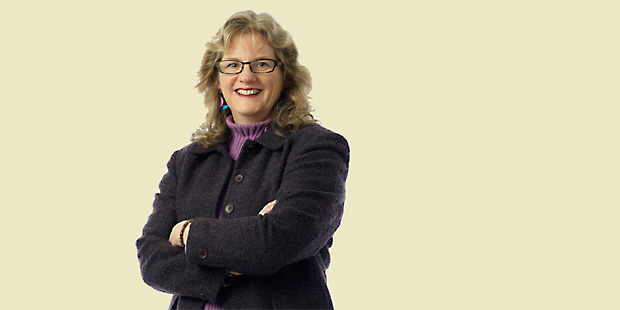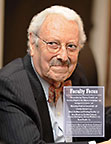Introducing Katherine Strandburg
Professor of Law
Printer Friendly VersionShe didn’t successfully crash-land a plane or seize the political spotlight, but Katherine Strandburg nonetheless got her proverbial 15 minutes of fame—via cans of mixed nuts. In 1987, while doing post doctoral work in physics at Carnegie-Mellon University, Strandburg and her colleagues figured out why Brazil nuts usually make their way to the top of the can, despite being heavier.
“Our explanation was very simple,” says the one-time physicist, who used computer simulation to explore the question. Each time the nuts bounce upward, more small spaces than large ones open up beneath them. Over time, the peanuts fall to the bottom because they have more places to go, pushing the Brazil nuts to the top. The team was besieged with media requests.
Few physicists get into the New York Times, and fewer still are women—only eight percent of all physics doctorates were earned by women when Strandburg received hers from Cornell University in 1984. She’d built a solid reputation with the Condensed Matter Theory Group at Chicago’s Argonne National Laboratory, publishing numerous scientific papers on phase transitions—points at which the type of ordering within a physical system changes—such as melting. So leaving the lofty world of physics in 1992 to start anew was a particularly gutsy move. But she realized the aspect of physics she relished most was analytical problem solving, and the problems that intrigued her most were social issues. Strandburg also loves a challenge—she’s a second-degree black belt in Seido Karate.
She entered law school at age 35. After earning her J.D. in 1995 from the University of Chicago Law School, she went to Jenner & Block, where she worked on patent and contract cases in which the underlying dispute involved technologies such as telephone billing systems and automobile diagnostic equipment. But in 2002 she switched gears again and moved into academia, teaching at DePaul University College of Law until leaving to join NYU Law.
“Kathy is universally loved and respected,” says DePaul law professor Roberta Kwall. “She’s intellectually curious. We have wonderful discussions about law, religion, and our daughters. She’s not just a one-dimensional thinker.”
Strandburg will teach intellectual property and law related to technology and innovation. “She is one of the best-appreciated legal scholars in the field of innovation research,” says economist Eric Von Hippel of MIT Sloan School of Management. Her article “Users as Innovators: Implications for Patent Doctrine” (University of Colorado Law Review, 2008) “is the first by any legal scholar that analyzes the significant implications of widespread user innovation for patent doctrine.”
In that piece, Strandburg challenges today’s predominant patent law doctrine, the seller innovator paradigm, which assumes that inventors are motivated by profit that can best be assured through patent protection. This paradigm, however, does not take into account that new products or processes are often invented by the users themselves, e.g., cyclists, snowboarders, and even research scientists, who benefit simply by using their own inventions. “So if people are inventing for reasons that don’t need a carrot,” says Strandburg, “then maybe we should have exceptions to the way patent law is enforced.”
In “Freedom of Association in a Networked World: First Amendment Regulation of Relational Surveillance” (Boston College Law Review, 2008), Strandburg explores privacy protections in our digital world. Current legal doctrines guard the content of phone or Internet communication but do little to prevent government from tracking our networks of contacts. At a time in which more and more people associate digitally, courts need to consider First Amendment freedom of association protections in regulating relational surveillance.
With co-authors Michael Madison and Brett Frischmann, Strandburg is also working on “Constructing Commons in the Cultural Environment,” which builds on “Users as Innovators” by proposing a theoretical approach to studying institutions for collaborative innovation, such as Wikipedia and open-source software. Says Strandburg, “My career in both law and physics is characterized by an interest in the way that large-scale, apparently coordinated phenomena emerge from the ground up—be it atoms, as in my studies on melting and quasicrystals; particles, as in the paper on Brazil nuts; or people, as in my studies of scientific collaboration.” Strandburg inherited her talent for science from her dad, Donald, 79, who taught physics at San Jose State University. She acquired her commitment to social issues from her mom, Patricia, 78, a one-time English teacher, who involved her three kids in volunteer activities like working at a summer camp for prisoners’ children. In law school, Strandburg helped to reunite a four-year- old girl from Honduras with her mother, a political refugee.
Both parents came from blue-collar families, but let Strandburg know she could be whatever she set her mind to—which changed daily in high school. “One day I wanted to do math, the next I’d be studying the classics,” she recalls. The only constant was science; she graduated with a B.S. in physics from Stanford in 1979.
A visiting professor in 2007-08, Strandburg cotaught the Colloquium on Innovation Policy. “She impressed everyone with her enthusiasm and commitment to intellectual life,” says her co-teacher, Rochelle Dreyfuss, Pauline Newman Professor of Law. “She brings a unique interdisciplinary perspective that adds to the way we think of intellectual property.”
The move to NYU brings her closer to her daughters from her former marriage, Danielle, 23, who lives in the city, and Ariana, 20, who is a student at Swarthmore College near Philadelphia. Once Strandburg settles into her new life in New York, she plans to throw her annual holiday party, to which she and her partner of 16 years, Wai-Kwong Kwok, an experimental scientist at Argonne, invite lawyer, scientist, and karate-enthusiast friends. They sing songs and munch on home-baked cookies and, of course, some mixed nuts.
–
All of 2009 Faculty Focus


 Multimedia
Multimedia